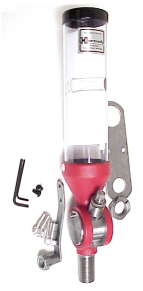 If you’re loading for the big Weatherby cartridges, or the new Ultra series, you’re probably running into difficulties locating a powder measure that will consistently throw accurate charges at 100 grain plus levels, assuming you can find one that will reach that level at all.
If you’re loading for the big Weatherby cartridges, or the new Ultra series, you’re probably running into difficulties locating a powder measure that will consistently throw accurate charges at 100 grain plus levels, assuming you can find one that will reach that level at all.
I contacted RCBS several times in search of a powder measure or approach to resolve this issue, but no solutions were forthcoming. Consequently, my loading bench was saddled with a Uniflow powder measure for small and moderate capacity cartridges, and a mechanical scale, or a Powder Pro/Powder Master Dispenser set up, for the big cartridges – accurate, but very cumbersome.
I kept imagining a new process that would measure by weight, only rapidly and accurately, however my designs always concluded with a small mouse, a treadmill and a conveyor belt. Then I read a press release from Hornadywhich announced the introduction of a high capacity powder measure for the .50 BMG, and a high capacity metering kit for the standard Lock-N-Load powder measure. Neat! I thought my days of watching a rising scale balance beam, or listening to the Powder Master motor groan might be nearing an end.
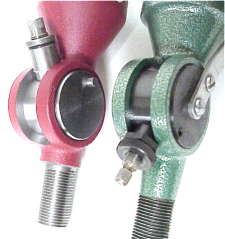 I found both a new Lock-N-Load measure and the metering kit, in stock, at Lock, Stock & Barrel. You can always tell a company that has good design staff. They really think about every aspect of the product they are working with, and directly in context with the people slated to use that product. As an example, I have a Ruger No.1 with a quarter ramp rear sight. The sight is also notched to act as a base for Ruger scope rings. Two more iterations of the design and that rear sight will include a Swiss Army Knife and toe nail clippers.
I found both a new Lock-N-Load measure and the metering kit, in stock, at Lock, Stock & Barrel. You can always tell a company that has good design staff. They really think about every aspect of the product they are working with, and directly in context with the people slated to use that product. As an example, I have a Ruger No.1 with a quarter ramp rear sight. The sight is also notched to act as a base for Ruger scope rings. Two more iterations of the design and that rear sight will include a Swiss Army Knife and toe nail clippers.
It’s obvious when looking at Hornady equipment, next to an RCBS product, that Hornady is very deliberate in their design efforts. There are many differences between the two brands.The cast funnel portion of the unit’s body, at the base of the Hornady hopper, is larger and provides greater powder mass transition from hopper to metering rotor. The result is more uniform filling of the rotor.
The metering assembly and track are machined to a close fit and the metering assembly’s flats maintain proper alignment to insure a smooth stroke and uniform feed. The same flats retain the metering assembly so it will not unscrew from the rotor while making powder throw adjustments; an annoyance I frequently encounter with the RCBS unit. The Hornady metering assembly is adjusted with a large knurled knob and sealed and tensioned with an “O” ring. This is in comparison to the awkward 1/4″ bolt, knurled locknut and flat spring that holds the RCBS unit together. The top of the threaded nozzle portion of the Hornady unit has a flat cut shoulder, allowing it to sit upright in the bench mount without the use of a backside lock nut to position it.
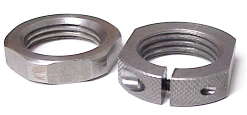 I’d be remiss if I skipped over this level of detail, because when a vendor will go through the trouble of providing better quality or better design, it should be acknowledged. There are extra process steps (costs) required to produce Hornady’s lock nut; splitting, knurling, cross drilling, lock screw, and more threads for a more secure hold. Very nice small touches.
I’d be remiss if I skipped over this level of detail, because when a vendor will go through the trouble of providing better quality or better design, it should be acknowledged. There are extra process steps (costs) required to produce Hornady’s lock nut; splitting, knurling, cross drilling, lock screw, and more threads for a more secure hold. Very nice small touches.
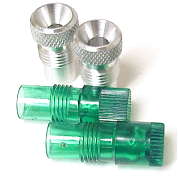 Even the drop tubes are different between the two brands. RCBS provides two plastic tubes to adapt to different calibers. Hornady, consistent with the rest of the product, provides nicely done aluminum parts that will not wear out or cross thread in normal use.
Even the drop tubes are different between the two brands. RCBS provides two plastic tubes to adapt to different calibers. Hornady, consistent with the rest of the product, provides nicely done aluminum parts that will not wear out or cross thread in normal use.
The Hornady castings are smooth and devoid of parting lines that would restrict powder drain into the rotor. The hopper is pinned in place rather then staked, permitting an easy change and a variety of hoppers to be offered, consistent with the intended charge size and usage. There is a small slip-on plastic cap that fits, rather than a pop-in plastic top that tosses powder when you try to remove it from a full hopper. All metal contact or bearing surfaces are finish machined and not covered with gloppy paint
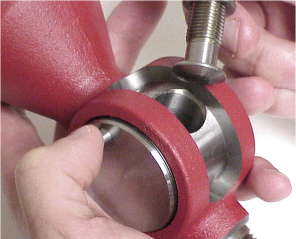 I have several micrometer metering assemblies for the RCBS Uniflow. It is a pain to disassemble the rotor and metering unit to make a change or even clean the darn thing out. Hornady uses a simple one hand push button quick release that allows instant removal of a metering assembly, or complete removal of the rotor.
I have several micrometer metering assemblies for the RCBS Uniflow. It is a pain to disassemble the rotor and metering unit to make a change or even clean the darn thing out. Hornady uses a simple one hand push button quick release that allows instant removal of a metering assembly, or complete removal of the rotor.
For as well as the Hornady unit is made, I would have expected it to be higher priced than the RCBS unit. Fortunately, this isn’t the case. While the added quality and features would typically interpret into a higher cost, this cost does not show up in the price. The Hornady street price is $51 compared to $59 for the RCBS unit. Quite frankly, there’s a lot of machine work and process steps for the price.
The Hornady High Capacity Metering Kit

 If you work with higher capacity cases, you know it does not take long to run through a hopper full of powder. The RCBS hopper has approximately 8 ounces of capacity, the Hornady approximately 16. The high capacity metering kit offered by Hornady under part number 050126 extends the hopper capacity (right) another 50%.
If you work with higher capacity cases, you know it does not take long to run through a hopper full of powder. The RCBS hopper has approximately 8 ounces of capacity, the Hornady approximately 16. The high capacity metering kit offered by Hornady under part number 050126 extends the hopper capacity (right) another 50%.
More important than the increased hopper size, are the additional metering assemblies and extended drop tube supplied which make good use of the use of the larger hopper. The standard metering assembly packaged with the Lock-N-Load powder measure will take you up through 100 grain charges. So if you are popping squirrels with a .375 H&H or .458 Winchester you’re covered you’re already covered.
The kit offers an extended range with two additional metering units; 80 – 180 grains, and 165-265 grain. If you are loading for an Ultra, or Weatherby .378 based cartridges, or the .338 Lapua, the 80 – 180 is perfect. You may not need the 165-265 grain unit, but you can’t one without the other. I don’t know why these are linked together, especially when Hornady already offer 4 other individual metering assemblies. The High Capacity kit is $48.95, the individual assemblies, $9.95.
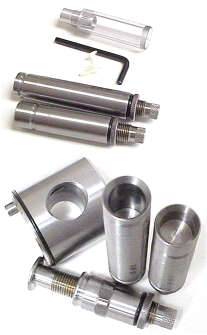 To the right are a couple of views of the various metering components, including the clear drop tube at the top of the picture. These mechanical measures are relatively simple in construction. The rotor that passes through the center of the measure’s cast body has a cavity of some capacity, typically 80 – 100 grains maximum. The metering assembly at the very bottom right is inserted into the rotor and blocks a portion of the rotor’s cavity. As the plug is adjusted out from the metering body, it allows more powder to flow into the increased cavity. The finer the threads of the metering assembly, the greater the resolution for adjusting charges. With the metering assembly turned all the way in, you may have a 5 grain charge, turned all the way out, you’ll get maximum.
To the right are a couple of views of the various metering components, including the clear drop tube at the top of the picture. These mechanical measures are relatively simple in construction. The rotor that passes through the center of the measure’s cast body has a cavity of some capacity, typically 80 – 100 grains maximum. The metering assembly at the very bottom right is inserted into the rotor and blocks a portion of the rotor’s cavity. As the plug is adjusted out from the metering body, it allows more powder to flow into the increased cavity. The finer the threads of the metering assembly, the greater the resolution for adjusting charges. With the metering assembly turned all the way in, you may have a 5 grain charge, turned all the way out, you’ll get maximum.
The high capacity metering units serve two purposes; they increased or extend the rotor’s capacity by providing a secondary cavity, and they provide adjustment for this extended range. This is a very simple, well thought out approach. Notice the “O” ring on the handle side of the rotor to support it in operation and prevent wear and tear. These are all very high quality machined parts and they fit together nicely.
Of course all of this looks nice, but needed testing and validation to qualify actual performance. I made the first step toward using a new powder measure; I cleaned it thoroughly. These are packaged in rust preventative which will absolutely kill any powder it comes in touch with. Fortunately, the measure is so easy to disassemble, cleaning was an easy proposition. I pulled the rotor out and disassembled each of the metering assemblies, and used a brush and powder solvent to make sure all rust preventative was pulled off of the long screw threads and from the metering body. I used a little dry lube on bearing surfaces, and reassembled everything.
Everything about powder measures you may not want to know
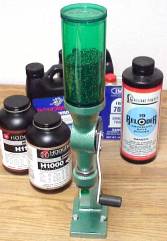 When it comes to handloading and working with components that are potentially hazardous, appearances may decorate the bench, but substance must rule the day. Yes, I know that is a pretentious and/or banal comment, but I’m permitted two per article.
When it comes to handloading and working with components that are potentially hazardous, appearances may decorate the bench, but substance must rule the day. Yes, I know that is a pretentious and/or banal comment, but I’m permitted two per article.
 I set up the RCBS powder measure stand, which works equally well for both the RCBS Uniflow and Hornady Loc-N-Load measures. Then I grabbed a bunch of powder in a variety of types: ball, stick and flake. I made sure to include some powders that notoriously presented metering problems such as IMR 7828 and Reloder 25. I also added a very fine granule fast powder normally associated with small charges; Blue Dot. I selected weight ranges consistent with the type of charges a handloader would typically encounter with each given powder type.
I set up the RCBS powder measure stand, which works equally well for both the RCBS Uniflow and Hornady Loc-N-Load measures. Then I grabbed a bunch of powder in a variety of types: ball, stick and flake. I made sure to include some powders that notoriously presented metering problems such as IMR 7828 and Reloder 25. I also added a very fine granule fast powder normally associated with small charges; Blue Dot. I selected weight ranges consistent with the type of charges a handloader would typically encounter with each given powder type.
I checked and calibrated my RCBS Pro scale and used it to measure each charge thrown by the mechanical powder measures. I also checked the scale periodically with check weights to make sure accurate scale readings were being generated. The scale operated perfectly but, as is the case with all electronic scales, it is sensitive to drafts, vibration and any nearby movement. As an example, at the onset of checking measure readings, I was reading off scale measurements just as the reading settled down and almost stopped blinking. The blinking indicates the scale is still taking a reading and is not displaying a final amount. I noticed the scale would almost settle than move again. The problem was traced to me. My speaking at a distance of two feet away from the scale was enough to change the scale reading – no doubt the effects of hot air.
| Charge Weight – 10 throws | ||||||||||||||||||
| Ball | Cylindrical | Cylindrical | Cylindrical | Ball | Ball | Cylindrical | Flake | Flake | ||||||||||
| Win 748 | R19 | R25 | IMR7828 | H110 | H870 | H1000 | Power Pistol | Blue Dot | ||||||||||
| R | H | R | H | R | H | R | H | R | H | R | H | H | R | H | R | H | R | H |
| 36.1 | 39.0 | 67.0 | 60.3 | 72.6 | 106.6 | 67.0 | 69.9 | 21.0 | 23.7 | 75.0 | 75.4 | 117.1 | 64.4 | 58.0 | 10.8 | 7.3 | 8.1 | 9.5 |
| 36.5 | 39.4 | 66.8 | 60.2 | 72.5 | 105.8 | 67.4 | 70.4 | 21.3 | 24.0 | 75.0 | 77.8 | 117.2 | 64.5 | 58.1 | 10.3 | 7.5 | 8.3 | 9.4 |
| 36.3 | 38.7 | 66.7 | 60.2 | 72.5 | 105.4 | 67.0 | 69.3 | 20.9 | 24.0 | 75.0 | 73.7 | 117.5 | 64.8 | 58.2 | 11.1 | 7.5 | 8.1 | 9.5 |
| 36.1 | 38.9 | 66.7 | 60.1 | 72.7 | 106.4 | 66.5 | 70.0 | 20.8 | 23.8 | 75.1 | 78.5 | 117.8 | 64.9 | 58.0 | 11.1 | 7.6 | 8.0 | 9.6 |
| 36.1 | 38.9 | 66.9 | 60.4 | 72.6 | 106.2 | 67.4 | 70.5 | 21.2 | 23.8 | 74.9 | 76.9 | 117.5 | 65.0 | 58.1 | 11.0 | 7.3 | 7.8 | 9.3 |
| 36.8 | 38.8 | 66.8 | 60.4 | 72.8 | 105.7 | 67.1 | 70.6 | 21.3 | 23.8 | 74.9 | 78.6 | 117.5 | 64.6 | 58.9 | 10.6 | 7.3 | 8.0 | 9.6 |
| 36.1 | 38.7 | 67.1 | 60.4 | 72.4 | 107.3 | 65.9 | 70.2 | 21.3 | 23.7 | 75.0 | 77.2 | 117.7 | 64.8 | 58.4 | 10.7 | 7.4 | 8.0 | 9.5 |
| 36.3 | 38.8 | 67.0 | 60.4 | 72.8 | 106.3 | 66.7 | 70.6 | 21.1 | 23.7 | 75.0 | 75.5 | 117.3 | 64.8 | 58.7 | 10.6 | 7.4 | 7.9 | 9.5 |
| 36.3 | 38.8 | 67.0 | 60.3 | 72.8 | 107.2 | 66.5 | 70.5 | 21.0 | 23.7 | 75.1 | 79.0 | 117.6 | 64.7 | 58.7 | 10.9 | 7.6 | 7.9 | 9.5 |
| 36.5 | 38.8 | 67.1 | 60.4 | 72.8 | 107.1 | 66.5 | 70.0 | 21.3 | 23.7 | 75.0 | 76.9 | 117.4 | 64.8 | 58.1 | 10.6 | 7.3 | 8.0 | 9.4 |
| Maximum variance low to high reading – grains | ||||||||||||||||||
| .7 | .7 | .4 | .3 | .4 | 2.4 | 1.5 | 1.3 | .5 | .3 | .2 | 5.3* | .7 | .6 | .7 | .8 | .3 | .3 | .3 |
| % variance to average charge | ||||||||||||||||||
| 2.2% | 2.1% | 0.6% | 0.5% | 0.6% | 0.2% | 2.0% | 2.0% | 2.0% | 1.2% | 0.3% | 4.5% | 0.6% | 0.9% | 1.2% | 7.4% | 4.0% | 3.7% | 3.1% |
Conclusion
Setting everything else aside, the Hornady measure with the 80-180 grain metering assembly worked like a champ on 100+ grain loads, most frequently maintaining a less than a .5% charge to charge variance.
Considering that some of the charge variances from either measure were greater than the normal min/max load spread of some cartridges, I believe I’d walk away from this experience realizing powder measures are not a tool to use in the volume production of maximum loads. At moderate charge levels, these should be just fine. It just doesn’t make sense to be on the edge, and worried about .2 grains more when your measure could easily be throwing full grain plus variances.
It took at least 5 throws of each powder type to get the measure to settle down and throw reasonably consistent charges. Loads were also more consistent with hoppers kept at least half full. The first point raises and interesting issue with initial rounds on an auto progressive press.
The *5.3 grain spread on H870 was caused by a static charge. I clip grounded the measure, worked with a wrist strap ground and anti stat sprayed the carpet under the bench. This worked really well and brought charges back into line with less than 1% variance in subsequent charges. Static charges appear to influence ball and similar powders much more than cylindrical powders. Wrist ground straps are available at any Radio Shack, and a good anti stat carpet spray is Windex.
I’m going to try some more Hornady equipment, and enjoy loading large cases with the Hornady measure. I believe they offer the solution I was looking for and deserve further consideration.
Thanks
Joe

Email Notification